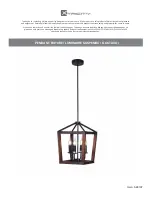
9 – Effects–Parameter details
TASCAM 788 Digital PortaStudio
89
De-esser
A de-esser removes the sharp “ess”
sounds from vocals and so on (hence its name). Some
vocal styles and some vocalists seem to need this
treatment, and others don’t seem to require it. A lot
also depends on your microphones, and their place-
ment. You don’t have to use a de-esser with vocals
only, but that’s usually where it does most good.
There are two parameters in the 788 de-esser:
Single stereo effect settings
The single stereo effects typically have more parame-
ters than their multi-effect “cousins”, but essentially
perform similar processing tasks on the signals.
Note that there is no on/off switch in these screens,
but that the final effect return level is always set
using an
OUT LEVEL
parameter at the bottom
of the setting screen for each effect. This takes a
value from
0
(no output) to
127
(full output).
REVERB
This reverb processor allows you to set a
simulated reverb type as well as other parameters
affecting the spacious reverberant sound.
DELAY
The “echo” settings here allow flexibility in
the type of delay as well as other parameters affect-
ing the delay sound:
CHORUS
A “doubling” effect, which thickens the
sound, giving additional character to it. Delay incor-
porated in this effect also helps to provide a fuller
sound.
Parameter
Min.
Max.
Explanation
FREQUENCY
1.0kHz
10.0kHz
Choose the minimum frequency at which the “ess” sounds are heard to cut them out of
the recording.
DEPTH
0
60
The depth of the de-esser’s effect
Parameter
Min.
Max.
Explanation
ROOM TYPE
Hall
Studio
Choose between Hall, Room, Live, and Studio to set up a reverberation pattern that
mimics these different scenarios
PRE DELAY
0ms
250ms
The time between the original signal and the start of the reverb
REV TIME
0.1s
10.0s
The time that the reverb sound takes to die away
DIFFUSION
0
100
The “liveliness” of the reverb sound, affecting the character of the “room” that you have set
up.
Parameter
Min.
Max.
Explanation
TYPE
Stereo
Multi
Choose the delay type from: Stereo (a stereo delay pattern), PinPon (a “ping-pong” delay
between the two stereo channels, or Multi (a multi-tap delay algorithm)
PRE DELAY
0ms
1000ms
The time between the original signal and the start of the repeated delays
FB DELAY
0ms
1000ms
The time between repeated echoes
FEEDBACK
0
100
The level of the repeated sounds (in practical terms, this controls the number of audible
repeats—note that a high value here may result in runaway feedback, which is
unpleasant)
Parameter
Min.
Max.
Explanation
RATE
0.1Hz
10.0Hz
The speed of the chorus effect
DEPTH
0
100
The depth (thickness) of the chorus effect
FB DELAY
0ms
100ms
The time between the original and the delayed signal
FEEDBACK
0
100
The level of the repeated sounds (in practical terms, this controls the number of audible
repeats—note that a high value here may result in runaway feedback, which is
unpleasant)
















































